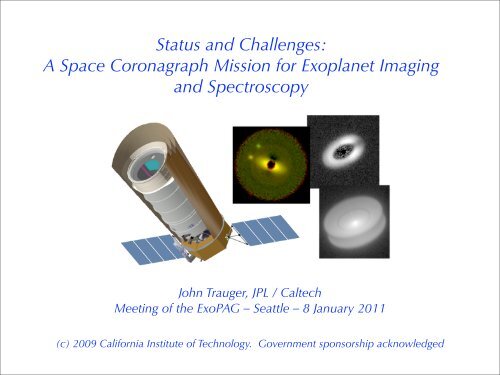A Space Coronagraph Mission for Exoplanet Imaging and ...
A Space Coronagraph Mission for Exoplanet Imaging and ...
A Space Coronagraph Mission for Exoplanet Imaging and ...
You also want an ePaper? Increase the reach of your titles
YUMPU automatically turns print PDFs into web optimized ePapers that Google loves.
Status <strong>and</strong> Challenges:A <strong>Space</strong> <strong>Coronagraph</strong> <strong>Mission</strong> <strong>for</strong> <strong>Exoplanet</strong> <strong>Imaging</strong><strong>and</strong> SpectroscopyJohn Trauger, JPL / CaltechMeeting of the ExoPAG – Seattle – 8 January 2011!(c) 2009 Cali<strong>for</strong>nia Institute of Technology. Government sponsorship acknowledged
Rally around the science• The Astro2010 calls <strong>for</strong> consensus on exoplanet mission readiness.• Rally around a compelling science mission with high readiness, elsecede the future of exoplanet missions to the next decadal survey.• The astrophysics of exoplanet systems is the compelling science ofthe coming decade, i.e., direct imaging <strong>and</strong> spectroscopy.• A successful concept also supports general astrophysics (UV-visibleimaging <strong>and</strong> spectroscopy) in the post-Hubble area.• A coronagraph mission serves a broad range of astrophysics, sincecoronagraph is in essence one selectable observing mode in a verystable general astrophysics space telescope.
<strong>Exoplanet</strong> Discovery <strong>Space</strong>Asterisks: known exoplanetsCurves: instrument capabilitiesColors: photometry b<strong>and</strong>sBlobs: regions of high likelihood<strong>for</strong> detection of Jupiter-twins <strong>and</strong>Earth-twins orbiting the nearest100 AFGK stars3
<strong>Exoplanet</strong> Discovery <strong>Space</strong>– Ground-based imaging observations – .beta Pictoris bLagrange et al. 2010HR8799 b,c,d,eMarois et al. 20104
<strong>Exoplanet</strong> Discovery <strong>Space</strong>– Hubble ACS coronagraph observations –Fomalhaut bKalas et al. 20086
Conceptual observatory:ACCESS = one of severalrepresentative 1.5-meter spacecoronagraphs!
<strong>Exoplanet</strong> Discovery <strong>Space</strong>– Extrapolation from 1.5 to 4 meter telescope aperture –“TPF”10
High readiness by 2014• Let’s not miss our last best chance <strong>for</strong> exoplanets at the mid-decade.• Compelling science, not the specific coronagraph design, is thejustification <strong>for</strong> an exoplanet mission.• Only high TRL coronagraph systems will be relevant in the middecadedecision.• Fish or cut bait: there will always be a “better idea” in the comingyear – holding out <strong>for</strong> “better” may defeat our opportunity <strong>for</strong> amission in the coming decade.• The general astrophysics community does not underst<strong>and</strong> – <strong>and</strong> isreluctant to endorse – high-contrast coronagraphs, hence we havean obligation to provide coherent <strong>and</strong> constructive discourse withour colleagues.
<strong>Exoplanet</strong> <strong>Mission</strong> Readiness Checklist✓ <strong>Coronagraph</strong> per<strong>for</strong>mance✓ Telescope thermal <strong>and</strong> dynamic stability✓ Telescope pointing control✓ Optical wavefront control <strong>and</strong> stability✓ Method <strong>for</strong> speckle / planet discrimination✓ Photon-counting imaging sensors✓ End-to-end per<strong>for</strong>mance models✓ End-to-end laboratory validations
<strong>Exoplanet</strong><strong>Coronagraph</strong>ReadinessContrastInner working angleSpectral b<strong>and</strong>widthThroughputWavefront Sensing <strong>and</strong> ControlLaboratory validations
The demonstrated state of exoplanet coronagraphyLyot coronagraph demonstrations <strong>and</strong> goalsContrast demonstrations with metallic <strong>and</strong> metal+dielectric Lyot masks:IWA = 3 λ/D, 20% BW, C = 2.7 e-9 (ACCESS, 2009)IWA = 4 λ/D, 10% BW, C = 6 e-10 (TPF-C M2, 2008)Milestone #1 <strong>for</strong> the hybrid Lyot TDEM program is:IWA = 3 λ/ D, 20% BW, C < 1e-9 (TDEM, 2011)• Profiled metal+dielectric layerscontrol complex (amplitude <strong>and</strong>phase) wavefront• Optimized design <strong>for</strong> improved contrast(3e-10) at 3 λ/D over 20% b<strong>and</strong>width,<strong>and</strong> throughput (60%) is the goal of a2010-11 TDEM program.!"#$,-$! %#!,-$! %"!,-$! %&!,-$! %)!"#$%&+$!'(!!!!"#$%""&!'(!!!!!!!!""&%")*!'(!!!!!!!!")*%&$&!'(!!!!!!!!&$&%&*+!'(!!!!!!!!!&*+%&+$!'(!!!,-$! %-$!14
The demonstrated state of exoplanet coronagraphyPupil mapping demonstrationsThe pupil mapping (PIAA) coronagraph has achievedIWA = 2 λ/D, monochromatic, C = 3e-8with the Generation 1 PIAA mirrors now on the HCITtestbed (Kern et al. 2010). Generation 2 mirrors,designed <strong>for</strong> 20% b<strong>and</strong>widths (Guyon 2008) havebeen manufactured by Tinsley <strong>and</strong> are now active onon the Ames testbed (Belikov 2010)blocked star location(half-plane blocked by aknife-edge occulter)15
The demonstrated state of exoplanet coronagraphyShaped pupil coronagraph experiments with HCITShaped pupil maskFocal plane maskHigh contrast fieldAt left, the transmittance profile of a representative shaped pupil apodization(black indicates opaque, white indicates clear). At center, the corresponding“bowtie” image plane mask. This “Ripple 3” design achieved 2.4e-9 contrast in10% b<strong>and</strong>width averaged over the 4-10 λ/D dark field (outlined) on the HCIT.(Belikov et al. 2007)
The demonstrated state of exoplanet coronagraphy!"#$%&'!%&$"(')%&%*+,&+-.'•!•!•!/.+0"12+0"3'#%&%*+,&+-.'45+66'7**"&'8%&97*,'+*,6":'.7,.'$.&%;,.-;$:'075-67#7$%*'D'%='3"E7#"0B''•! 4"#%*31%&3"&'5+090'7*0$+66"3'+$'/+6%5+&:';0"3'$%'75+,"'"(%-6+*"$0'+*3'#%5-+*7%*0'3%8*'$%'D1F'GH3'7*'$."'*"+&17*=&+&"3';07*,'+3+->E"'%->#0I'•! J%;&$.1%&3"&'5+09'$"0$"3'7*'$."'E70726"'%*'$."'K)LM'7*'FNNO'?PDN 1Q' %E"&'DNR'STA'–! C"*"&+>%*'FB'•! M"#.*%6%,7#+6'3"E"6%-5"*$'U*+*#"3'$.&%;,.'V/WV'+*3'4SLW'-&%,&+50'•! L5-&%E"3'3"U*7>%*'%='$."'#"*$"&'''?XN'Y5'Z['\'Y5A'•! V#.&%5+>#'?,%+6'DN 1]' %E"&'FNR'STA'4"&+2
The demonstrated state of exoplanet coronagraphyVisible nuller coronagraph• VNC development is active atGSFC (Lyot et al.) <strong>and</strong> at JPL(S<strong>and</strong>hu et al.)• Segmented MEMS DMs fromboth Boston Micromachines <strong>and</strong>IRIS-AO are under consideration.• Spatial filters, consisting of abundle of 1000 single modefibers coupled with lenslet arrays,are now being perfected <strong>and</strong>tested.• Starlight suppression of 1e-8 hasbeen demonstrated in laser light(Lyot et al. 2010).18
All coronagaphs require de<strong>for</strong>mable mirrors<strong>for</strong> precise wavefront controlHCIT experiments have been carried out withXinetics DMs. Fused silica facesheet is polishednominally to λ/100 rms. Surface figure (openloop) has been shown to be settable to 0.05 nmrms <strong>and</strong> stable to 0.01 nm rms over periods of 6hours or more in a vacuum testbed environment.Protoflight qualification is in progress at JPL.MEMS DMs manufacturedby Boston Micromachines(left) <strong>and</strong> IRIS-AO (right)can be configured witheither continuous orsegmented mirrorfacesheets. MEMS DMs areactively in use in alltestbeds other than HCIT.
The demonstrated state of exoplanet coronagraphy• Laboratory verified per<strong>for</strong>mance provides objective criteria <strong>for</strong>comparisons among the representative coronagraph types.• Demonstrated raw contrast, spectral b<strong>and</strong>width, inner workingangle, throughput, cost/complexity, can be used to in<strong>for</strong>m ahigh fidelity exoplanet mission simulation.20
<strong>Exoplanet</strong> Discovery <strong>Space</strong>– Per<strong>for</strong>mances goal <strong>for</strong> the coming three years) –21
<strong>Exoplanet</strong> Discovery <strong>Space</strong>– Extrapolation from 1.5 to 4 meter telescope aperture –“TPF”22
Next three years are critical <strong>for</strong>concept validation• Advances in demonstrated contrast, spectral b<strong>and</strong>width, innerworking angle, <strong>and</strong> nulling algorithms by 2014.• Laboratory validation of per<strong>for</strong>mance models, including pointingcontrol methods <strong>and</strong> strategies <strong>for</strong> planet/speckle discrimination.• Validation of high contrast imaging, wavefront control, <strong>and</strong> specklediscrimination with a flight-configured coronagraph instrument in aflight simulating environment.• Develop a compelling exoplanet reference science missiongrounded on validated coronagraph per<strong>for</strong>mance models.23
Next three years are critical <strong>for</strong>building consensus in the exoplanet community• The past few years have seen good progress, spurred on byinstitutional investments as well as NASA programs.• Thanks to NASA <strong>for</strong> the ASMCS <strong>and</strong> TDEM programs, which enabledthe community to set relevant <strong>and</strong> timely goals (milestones) that arefresh <strong>and</strong> current in the thinking of the exoplanet community.• But! Are the research <strong>and</strong> development enabled by NASA programs(SAT, APRA) adequate to bring exoplanet technologies to a readinesslevel that justifies the endorsement of the astronomy community?• We need to rally our community around a compelling exoplanetreference science mission grounded on validated coronagraphper<strong>for</strong>mance models.24
End25
















